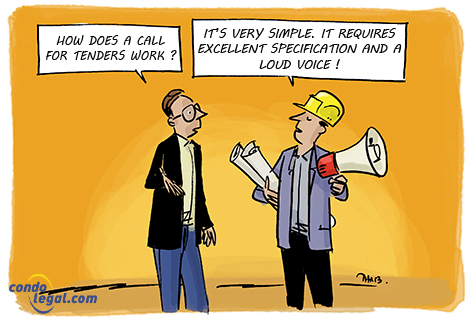 Work to be carried in common portions is to be undertaken by the syndicate of co-owners. In its capacity of the client, he is the instigator and the beneficiary thereof. It prepares the specifications and consequently the needs, the budget, the provisional calendar and the objectives to be achieved. In relation to such work, the syndicate should always be governed by its mission. It should never act as a substitute for the general contractor, such as mandating the subcontractors directly to do the work, or by interfering in the conduct of the construction site, in the place and stead of the people responsible therefor.
Work to be carried in common portions is to be undertaken by the syndicate of co-owners. In its capacity of the client, he is the instigator and the beneficiary thereof. It prepares the specifications and consequently the needs, the budget, the provisional calendar and the objectives to be achieved. In relation to such work, the syndicate should always be governed by its mission. It should never act as a substitute for the general contractor, such as mandating the subcontractors directly to do the work, or by interfering in the conduct of the construction site, in the place and stead of the people responsible therefor.
Building professional: a key player
Normally, the syndicate is competent to supervise the performance of minor work, such as that involving a trade. However, for any construction site requiring the participation of several trades, it will generally have to be assisted by experienced building professionals. These professionals entail a cost, but they could end up saving the syndicate a lot of money, especially if the site is more complex than expected, or if the work is of a lower quality than originally planned. The participation of one or more professionals may therefore be necessary in certain circumstances.
Directors with relevant experience in major building work are rare indeed. Those who believe they are capable of managing such work are better to deliver the goods, otherwise they may engage their personal liability. Unfortunately, some of them are foolhardy enough to think that they do not need a professional to successfully complete such work.
Not only do you need to retain the services of an architect, of an engineer or of a professional technologist to handle large-scale work, but you would also be well advised to entrust to the latter the management of each stage leading to completion. First and foremost, he will conduct an inspection of the immovable, and then prepare a detailed report outlining the issues, if any. The next step will be to prepare plans and specifications. These plans will include drawings indicating where the work is to be done. As for specifications, they list products and material to be used, and specify how they should be installed.
Call for tenders
The preparation of tender documents, whether public or by invitation, is the next step after plans and specifications. The call for tenders, by which a client (or a potential buyer) asks several enterprises companies to give a price to perform work, is ultimately intended to facilitate one of them being selected. This procedure places various bidders in competition to identify the one that best meets the needs of a co-ownership, based on its expertise and the asking price.
Preparing and sending out calls for tenders should never be entrusted to a neophyte, as the risk of errors is extremely high. In the event of the omission of an important provision or of a standard guarantee, allowing the successful bidder to take advantage by claiming a prohibitive extra, the one who prepared them could find himself in hot water. In co-ownership, several professionals launch calls for tender on invitation, that is to say they choose the contractors invited to bid.
What does the call for tenders contain?
One of the key elements of a call for tenders concerns the general terms and conditions of the worksite, such as the date of commencement and of the completion of the work. It will also mention who supplies electricl power and sanitation, and if special measures are needed, such as if the work is carried out in winter. The minimum amount required for the contractor's insurance coverage is also indicated. It could also require a performance bond, to insure the completion of the work by another enterprise, or the payment of the costs necessary for its completion, if the first contractor cannot complete the work.
It is also crucial to clarify (in the call for tenders) who will carry out the work, to avoid that at the commencement of the work, another contractor shows up without the syndicate being notified. In this type of situation, the substitute could be less qualified, and his team could be made up of apprentices. A similar scenario ended up before the Court of Quebec - Small Claims Division, because the worksite was abandoned before the completion of the work .Serious calls for tenders are addressed to reputable contractors with a good track record and who respect quotes and deadlines.
Low quality
The intervention of a professional during all stages of the work will prevent other potential concerns, resulting from low quality work. This can happen if the syndicate prepares the tender documents by itself, and that it does not have sufficient knowledge of the products and material available on the market. For example, a bidder may suggest using cheaper products than those required in the call for tenders at an unjustifiable cost. In the case of roof repairs, to cite an example, if the manufacturer's bilayer elastomeric membrane “x” is required, and company “y” is suggested instead, a construction professional will ensure that the second option will not compromise the integrity of the work.
To this end, he will validate with the bidder that the functionality and quality of the replacement product are equivalent. Technical specifications will be requested to verify if this is the case. It is only afterward that a decision will be taken, so that in the final analysis, a co-ownership will have on hand bidding documents in which the products are comparable. Its directors will thus be able to choose their contractor knowingly, by following (or not) the recommendations made by the professional in charge.
Supervision of the work
The contractor chosen should be supervised; the professional can be mandated to do so. Many syndicates neglect this requirement on account of the additional costs. However, it can be very rewarding to invest a little more at this stage, to avoid defective execution of the work, which could lead to a rude awakening in the medium term. Surveillance entails that the professional will ensure, inter alia, the contractor’s fully compliance with the plans and specifications.
Once the work completed, the board of directors shall proceed to the acceptance of the work with or without reservations, as necessary. The acceptance will confirm (or not) the conformity of the work with the contractor’s contract, and that the work was carried out under the previously established terms and conditions. If the work does not meet these two criteria, the syndicate shall use its guarantees, after establishing the contractor’s liability.
 WHAT YOU SHOULD KNOW ! To carry out work that needs to be executed carried in the co-ownership, the syndicate should proceed in stages. There is no absolute rule in such matters.
WHAT YOU SHOULD KNOW ! To carry out work that needs to be executed carried in the co-ownership, the syndicate should proceed in stages. There is no absolute rule in such matters.
 WHAT TO KEEP IN MIND : When major work is planned in a co-ownership, the intervention of a building professional is often required. Whether it is controlling costs, technical challenges and coordinating the various stakeholders, he can be invaluable during all stages of the project, from the early design to the completion stage of the work. A professional may also assist the syndicate in creating an asset management plan of the immovable that satisfies legal requirements. This approach is proactive rather than curative.
WHAT TO KEEP IN MIND : When major work is planned in a co-ownership, the intervention of a building professional is often required. Whether it is controlling costs, technical challenges and coordinating the various stakeholders, he can be invaluable during all stages of the project, from the early design to the completion stage of the work. A professional may also assist the syndicate in creating an asset management plan of the immovable that satisfies legal requirements. This approach is proactive rather than curative.
 WARNING ! All contractors (with exceptions) must hold a license to offer their services in Québec. It is issued by the “Régie du bâtiment du Québec” (RBQ). One must also verify that the license category is the right one for the work. The contractor chosen is also required to have a license security. This financial guarantee is intended to compensate clients who have suffered damages resulting from "non-performance" or "performance" of work. It relates to prepaid amounts, non-completion of work, defective workmanship and defects discovered in the year following completion.
WARNING ! All contractors (with exceptions) must hold a license to offer their services in Québec. It is issued by the “Régie du bâtiment du Québec” (RBQ). One must also verify that the license category is the right one for the work. The contractor chosen is also required to have a license security. This financial guarantee is intended to compensate clients who have suffered damages resulting from "non-performance" or "performance" of work. It relates to prepaid amounts, non-completion of work, defective workmanship and defects discovered in the year following completion.
